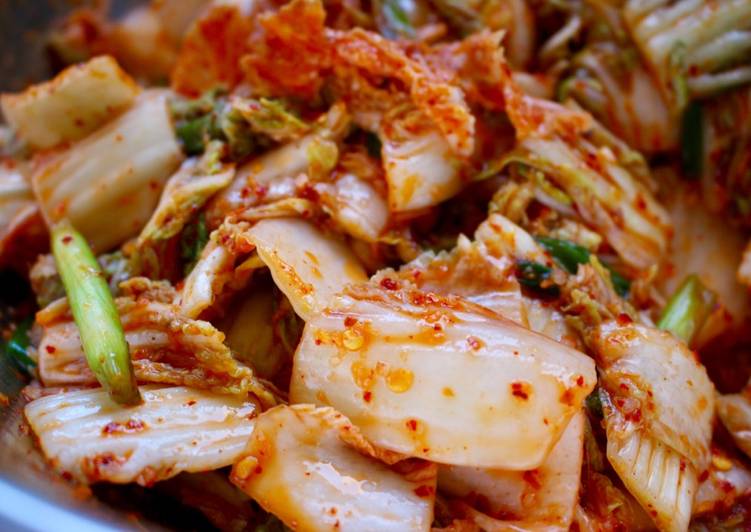Kimchi (Easier than you think! ;) ). Kimchi is a traditional Korean dish of fermented vegetables and spices, in particular ginger, garlic, peppers and hot chilies. Kimchi: AKA fermented cabbage, is one of the healthiest foods for your gut. Chef Randy Feltis shares how to make the dish yourself.
 At the end of the day, it's.
Today I'd like to share an easier version of Korean kimchi.
It's made with only a few simple ingredients and is dead easy to pull off.
You can Have Kimchi (Easier than you think! ;) ) using 11 ingredients and 9 steps. Here is how you achieve that.
At the end of the day, it's.
Today I'd like to share an easier version of Korean kimchi.
It's made with only a few simple ingredients and is dead easy to pull off.
You can Have Kimchi (Easier than you think! ;) ) using 11 ingredients and 9 steps. Here is how you achieve that.
Ingredients of Kimchi (Easier than you think! ;) )
- What You needis 4-5 pounds of Napa cabbage, cut into roughly 1"x 2" pieces (about 30 cups of chopped raw cabbage).
- Lets Go Prepare 1 bunch of green onions, washed, roots trimmed, and cut into 2 inch segments.
- Lets Go Prepare 5 Tablespoons of kosher salt (about 10% less if you're using regular table salt).
- Lets Go Prepare of For the paste:.
- What You needis 1/4 cup of minced garlic (about 5 or 6 large cloves).
- It's 1/4 cup of minced fresh ginger root (about a 2" segment, peeled).
- Lets Go Prepare 1/4-1/2 cup of crushed red chili flakes depending on how hot you want your kimchi. See notes above re: gochugaru.
- Lets Go Prepare 1/4 cup of steamed white rice, lightly packed. Short or long grain is fine. If stale, microwave with 2 Tbsp. water for 1 minute.
- It's 1/4 cup of fish sauce.
- What You needis 1/4 cup of sugar.
- Lets Go Prepare 1/4 cup of water for blending + 1/3 cup water for rinsing seasoning from bowl (see directions below).
Traditional Korean kimchi is wonderful, but it requires more complex steps and ingredients that are harder to source. I wanted to make this doable for the average American. Both Kimchi and beef are tender and delicious! I think its intended to be served more on the fresh side than well fermented.
Kimchi (Easier than you think! ;) ) instructions
- In a large stainless steel or mixing bowl, toss the raw cabbage, green onion, and the salt together to pre-brine the cabbage. Make sure to thoroughly incorporate the salt throughout the cabbage. In 10 to 15 minutes, you should start to see the cabbage leach liquid and wilt. Let the cabbage sit for 1.5 to 2 hours, tossing and redistributing every 30 minutes to ensure even brining..
- After at least 90 minutes of pre-brining, rinse the cabbage with enough water to cover the cabbage by 4 or 5 inches by swishing the cabbage in the water 7 or 8 times. Remove the cabbage into a strainer and let the excess water drain while you prepare the paste..
- Make the paste by putting all the paste ingredients into a blender and blend until you can't see the individual grains of rice. Pour the paste over the cabbage..
- Get into the bowl with your hands and mix the paste into the cabbage until all the pieces are evenly and thoroughly coated..
- Pack your kimchi into a clean, dry bottle or other tight-lidded container (this time I repurposed a half gallon kimchi jar) and use the last 1/3 cup of water to swish around the mixing bowl, pick up all the remaining paste, and pour that liquid on top of your kimchi. Remember to leave 2 to 3 inches of headspace at the top to allow for expansion as fermentation takes place..
- Your batch of kimchi is now ready for fermentation in a dark but not cold place like the inside of your cupboard. Or, if you can find a warmish spot in your garage, you can put it there. (I know that's not always possible for cold climate people in the middle of winter.) As it ripens, it's a good idea keep the lid slightly unscrewed to relieve the pressurization caused by fermentation. (Your jar can literally explode from the pressure on a specially active fermentation day.).
- People often ask HOW RIPE DOES THE KIMCHI HAVE TO BE BEFORE I REFRIGERATE OR EAT IT? You can eat the kimchi whenever you want. Fresh, just after it's been made, all the way up to when it's so incredibly old, ripe and stinky you could choke out a subway system by placing an open jar in one of the vents. It remains safe for human consumption for A VERY LONG TIME..
- But as to when to refrigerate, just go out once a day every day to taste a piece, and when it gets to the ripeness you like, stick it in the fridge. It'll continue to ripen, but very slowly..
- Enjoy! :).
Thanks for your easy lovely recipe. I put my kimchi to fridge right away after i made it yesterday. And today i put iy outside since i searching and find that what i did was wrong. Yeolmumul kimchi is a less spicy kimchi made with young radish stalks floating in a tangy soup. When people think Asian cuisine, they often think soy sauce.